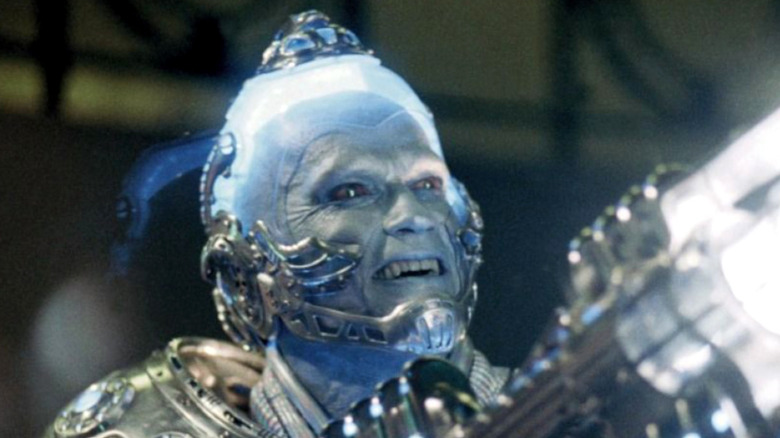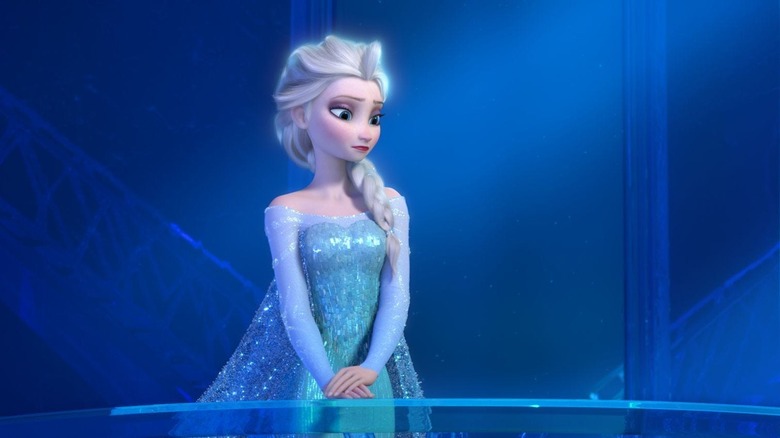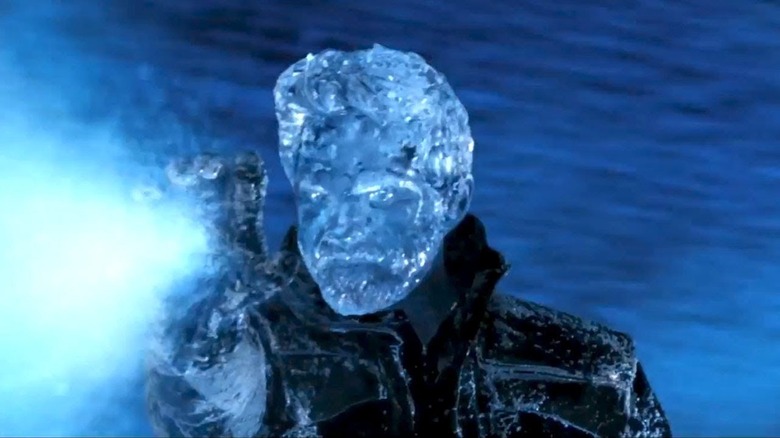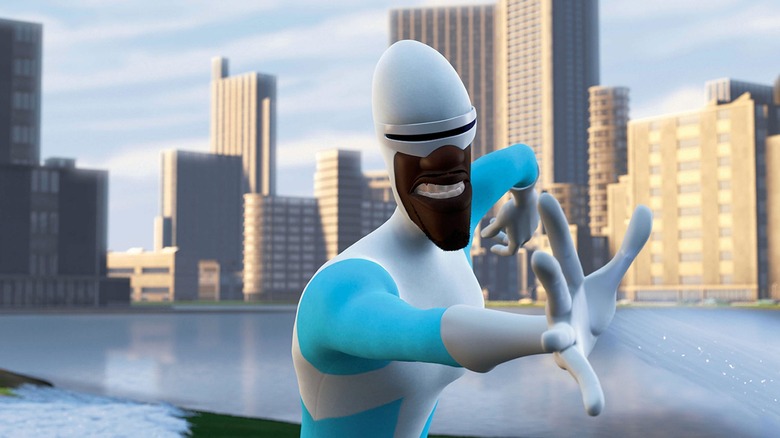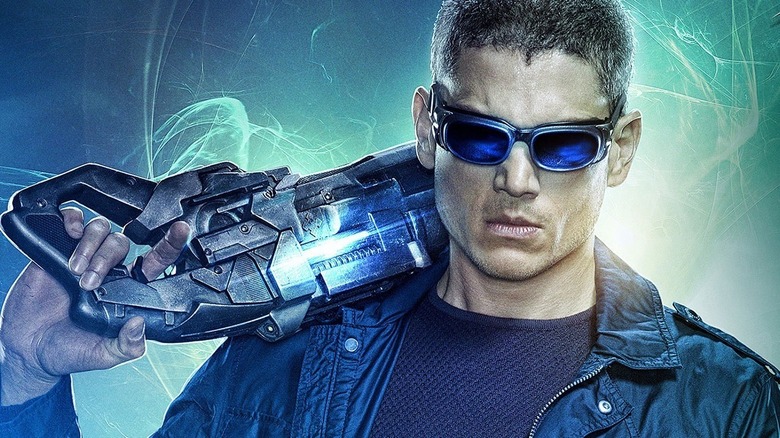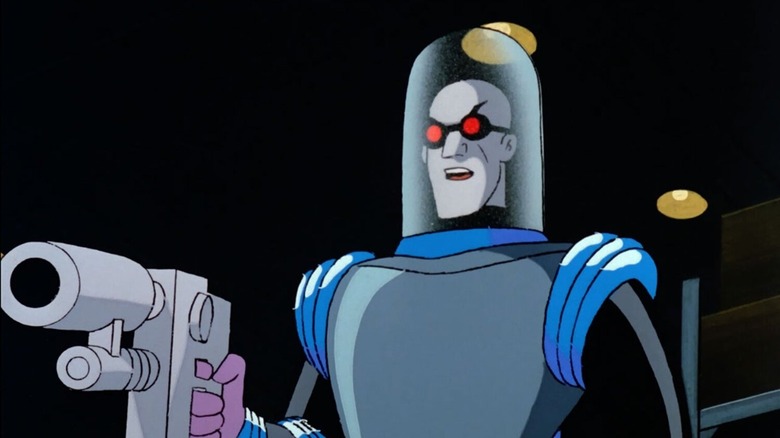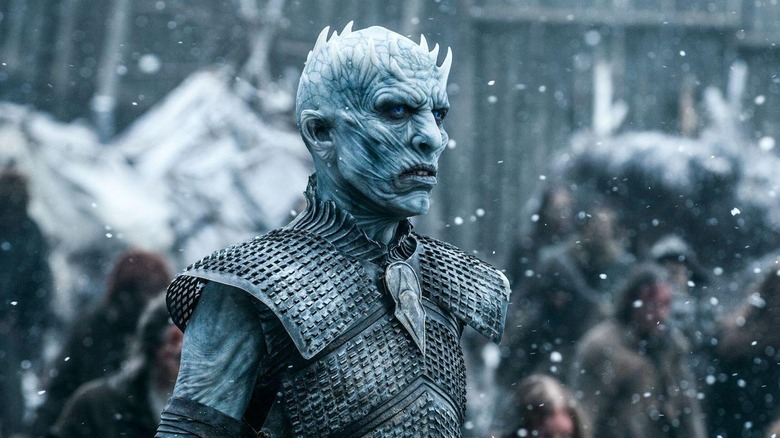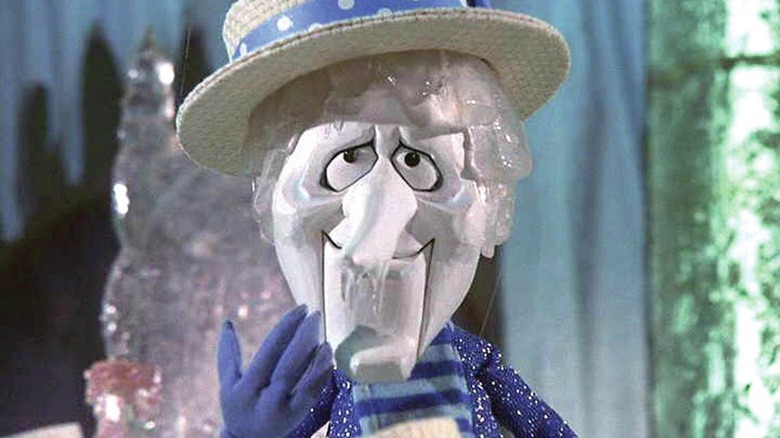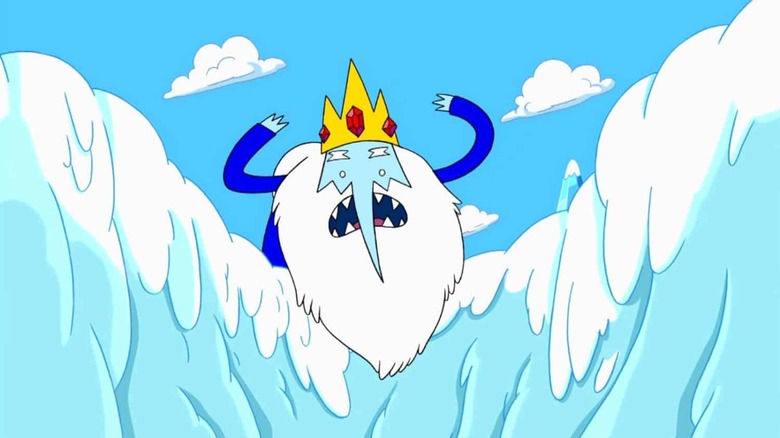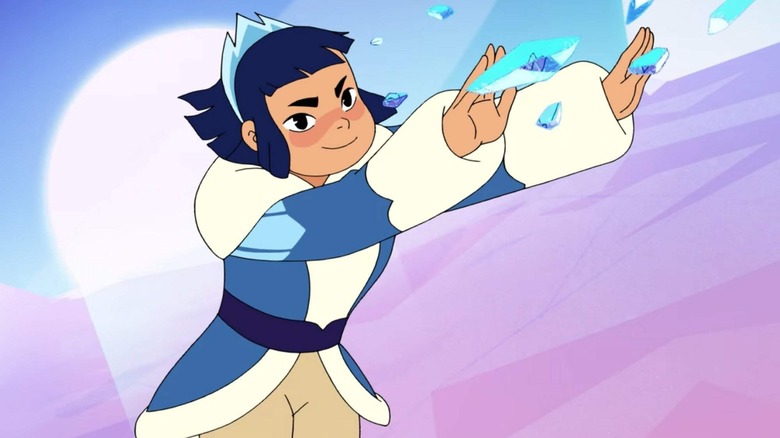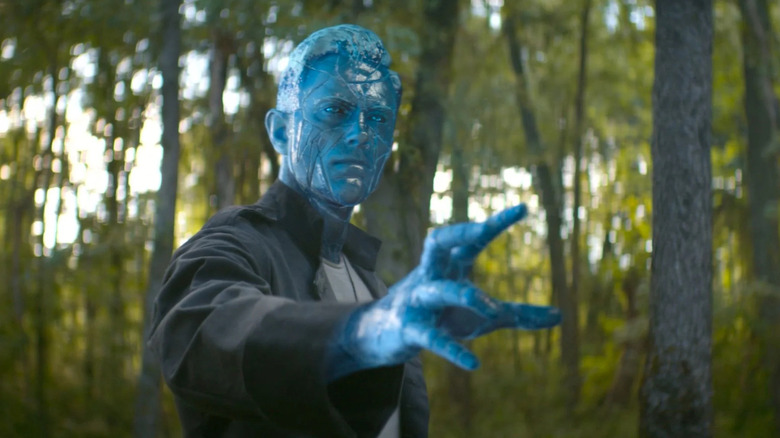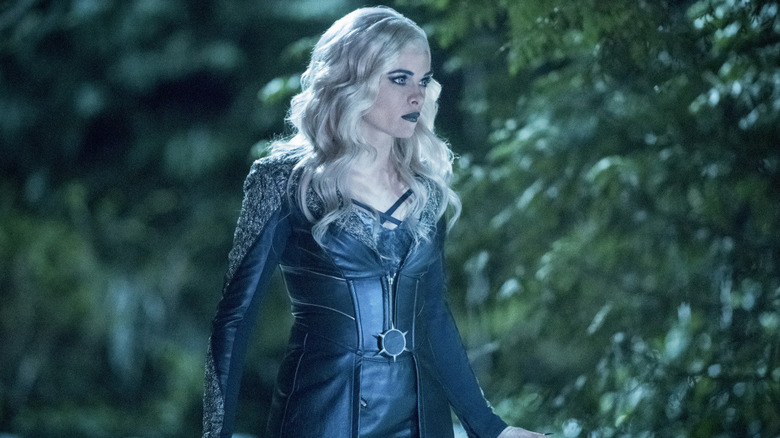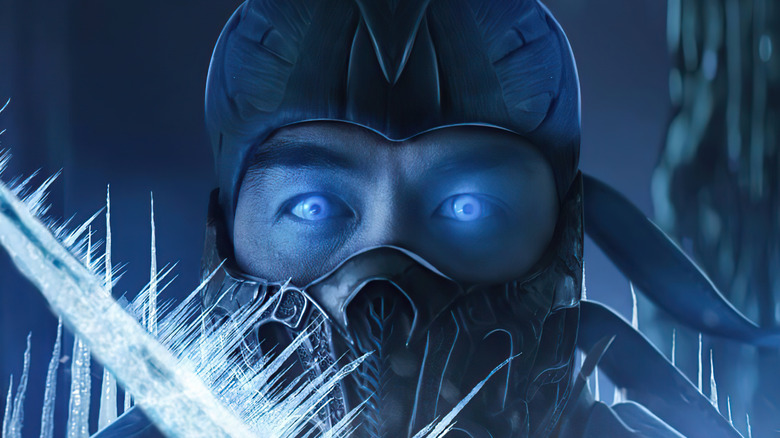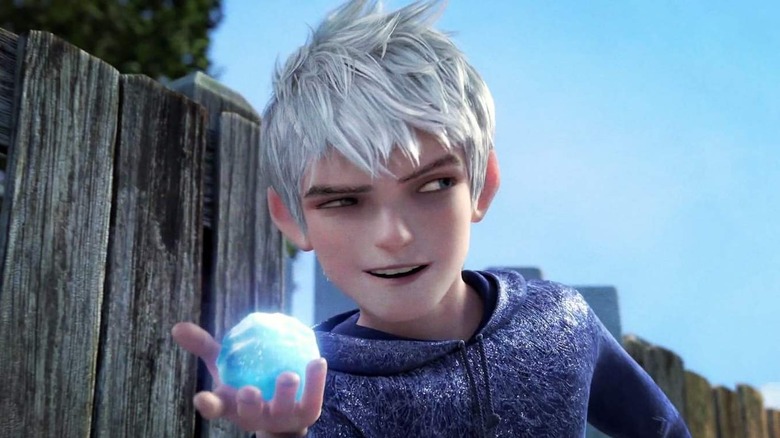The Best Movie And TV Characters With Ice Powers
"What killed the dinosaurs? The Ice Age!" That may not be strictly true (these days it's generally accepted there was a meteor involved), but it's a memorable claim made by Mr. Freeze in "Batman and Robin." And yes, we'll talk more about Mr. Freeze soon enough. But his one-liner speaks to the inherent power and danger of ice, snow, and cold weather. That danger's real, too—winter weather will literally kill you if you get stuck out in it. So it's no surprise that control of cold and ice is a common superpower. It's especially prevalent among villains, but there are some very important heroes who draw from that same icy well.
It's not just a superhero/supervillain thing, either. There are also characters in other kinds of fantastic stories who are known for controlling the winter elements, including the first one on this list, who for the last few years has been one of the most popular children's characters of all. So let's get on with it and look at—in no particular order—13 of the all-time greatest screen characters with ice powers.
Princess Elsa
Elsa from Walt Disney's "Frozen" isn't a superhero, but she does have impressive superpowers, and she's definitely a hero to many children who've watched that movie (and its sequel, "Frozen II") over and over again. Her signature song from the first movie, "Let It Go," became so ubiquitous after the film's release in 2013 that every parent knew all the words whether they wanted to or not. Broadway star Idina Menzel voices Elsa in both movies, lending not only her incredibly powerful singing voice, but also her facility for high-stakes emotional drama.
Princess of the mythical kingdom Arendelle, Elsa was born with the ability to conjure and manipulate snow and ice. As a child she accidentally injures her younger sister Anna, so her parents teach her to repress her powers and isolate herself, hoping to keep anyone else from getting hurt. Alienated from each other, Elsa and Anna face even more loneliness after their parents die in a shipwreck. On the day of her coronation, Elsa accidentally reveals her powers to the public in an argument with her sister, causing people to think she's some sort of monster. Elsa flees to the mountains, and the kingdom is thrust into unending winter. Finally embracing her powers (hence, "Let It Go"), Elsa builds an ornate castle of ice where she plans to live in isolation, but of course Anna comes looking for her. After some dramatic twists and turns, and several more songs, Elsa ends the unnatural winter and returns to be a good queen of Arendelle, with her beloved sister at her side.
"Frozen" is loosely based on Hans Christian Anderson's "The Snow Queen," in which the otherwise nameless title character is far more mysterious and ambivalent. Disney transformed her into something ironically much warmer but still surprisingly complex, and children have been eating it up ever since.
Iceman
Bobby Drake was born an ice-powered mutant, and he was one of Marvel Comics' original X-Men. He first became a star on screen in 1981, when he was chosen as one of the main characters of "Spider-Man and his Amazing Friends," alongside the titular web-slinger and an original character named Firestar. While the typical writing of 1980s kids' cartoons didn't allow for much characterization, he did get an origin episode, and his history with the X-Men was part of the fabric of the show. Animation was perfect, on the other hand, for depicting his ability to travel by creating ice-slides through the air, leaving roller-coaster–like ice structures in his wake. Voice acting legend Frank Welker played Iceman on the show.
When "X-Men" came to the big screen in 2000, Iceman came with them, played by Shawn Ashmore. He had a very small part in the first film, but was central to "X2" and "X-Men: The Last Stand." It's only in the climax of the third film that he finally displays the ability to take on an icy physical form as he does in the comics, as opposed to just projecting cold and ice from his regular human-looking form. He's back to a bit part in "X-Men: Days of Future Past," but the future battle with the Sentinels is the most accurate depiction of his comic-book powers yet seen onscreen, complete with ice-form and ice-slides.
In more recent comics, Bobby Drake has come out as gay, which Shawn Ashmore has expressed interest in depicting on screen, but time will tell if that comes to pass.
Frozone
Pixar's "The Incredibles" depicts an all-new world of superheroes full of recognizable archetypes from Marvel and DC Comics, but with new names and identities used to tell a more family-oriented story. Frozone is Mr. Incredible's best friend, an ice-powered superhero who's voiced by Samuel L. Jackson and looks a bit like him, too. When the first movie begins, superheroes have effectively been outlawed, forcing the former costumed adventurers into normal lives of quiet desperation. When Mr. Incredible can't take it anymore, he and Frozone start going out secretly and looking for crimes to stop, while lying to their wives that they're just bowling. When superheroes are brought back into the public's trust, he's happy to get back to the costumed life.
Frozone has the standard set of cold-themed powers: firing blasts of cold from his hands, freezing water or even the moisture in the air, and even making ice slides like Iceman, all of which look great in that crisp Pixar animation.
Captain Cold
Leonard Snart, as played by Wentworth Miller, was just a regular criminal until he acquired a cold-generating gun that could freeze things to absolute zero. Taking the name Captain Cold, he battled Barry Allen on "The Flash," but turned out not to be such a bad guy, as bad guys go. In time he redeemed himself fully, and became part of the time-traveling team of heroes on "Legends of Tomorrow," alongside his best friend Heat Wave, aka Mick Rory. When Mick became a villain once again after being lost in time, Leonard was dedicated to reforming him, and eventually succeeded. Captain Cold even died a hero, sacrificing himself to defeat the duplicitous Time Masters. That wasn't the last time he was seen, however. A villainous past version of the character traveled to the present as a member of the Legion of Doom, and later a heroic incarnation from an alternate Earth was around for a storyline as well.
Of course, Captain Cold was around long before the CW DC TV franchise, or even the CW itself. He debuted in comics in 1957, and first came to TV as part of the original Legion of Doom on the classic 1970s animated series "Challenge of the Superfriends," where he was voiced by Dick Ryal. In 1991, Michael Champion played a loosely adapted version of the character on an episode of the original "Flash" TV series. As a prominent member of the Flash's Rogues Gallery, Cold has also appeared on other series including "Justice League Unlimited," "Batman: The Brave and the Bold," and "Young Justice."
Mr. Freeze
Originally, Mr. Freeze was just another villain with a freeze ray. Called Mr. Zero in his first appearance, he was renamed for the 1966 "Batman" TV show, and the name followed him back to comics. Over the course of "Batman," he was played by three different actors, all of them legends in their own right: George Sanders, Otto Preminger, and Eli Wallach. In comics and on television, he was depicted as an intelligent criminal who had invented a gun that freezes things in ice, but thanks to an accidental explosion involving the gun, Freeze could only survive in a subzero environment, requiring him to wear a special suit. For decades, that's all there was to Mr. Freeze—a guy in a metal suit with a cold gun. The only thing that distinguished him from Captain Cold was that the latter could survive at room temperature.
Then the 1990s came along, and "Batman: The Animated Series" made Mr. Freeze into a tragic and even sympathetic figure. Victor Fries was a scientist who was deeply in love with his wife, Nora. When she contracted a terminal illness, he dedicated himself to cryogenic research that he hoped could prolong her life. When his boss interfered with the experiment, it led to the accident that turned Fries into Freeze. He continued to long for and carry on one-sided conversations with Nora, even though she was seemingly dead. She later turned out to be alive and frozen in suspended animation, but Freeze still had no way to revive or heal her. Over time, Freeze's condition caused both his body and his humanity to deteriorate, until on "Batman Beyond" he's just a disembodied head on robotic spider legs.
The same tragic origin was used for Mr. Freeze in Joel Schumacher's "Batman & Robin." As played by Arnold Schwarzenegger, however, Freeze was a comic character who made constant ice puns, lacking the pathos of his animated counterpart.
The Night King
The motto of House Stark and a frequently repeated phrase on "Game of Thrones" is "Winter is coming." It turns out that the fast-approaching winter that threatens the land of Westeros is more than just a changing of the seasons or a shift in weather. It's also a supernatural invasion led by a monstrous figure who embodies cold, ice, and death: the Night King. Played in his early appearances by Richard Brake, the Night King is the malevolent leader of the White Walkers, a group of powerful icy immortals who turn everyone they kill into wights (basically frigid zombies) under their control. In a flashback, the Night King is shown as a human man who was transformed by the Children of the Forest (the "Game of Thrones" version of fairies) into his current form thousands of years ago, as a weapon against their human enemies. In the present, however, the Children of the Forest have long since lost control of their creations and fear them almost as much as humans do.
The Ice King's primary power is creating wights, but snow, ice, and cold follow him wherever he goes, making it difficult for vulnerable humans to even get close to him and his army. Later in the series, Vladimir Furdik took over the role from Brake. The Night King uses an icy javelin to kill the dragon Viserion, transforming it into an undead ice dragon which he uses to destroy the wall that protects Westeros from the dangers of the far north. Viserion becomes the Night King's mount for the final battle, but after being forced to dismount he's ambushed and destroyed by expert assassin Arya Stark, ending his icy threat forever.
Snow Miser
Snow Miser is one of the silliest characters on this list, but he's also probably the most powerful. Voiced by comedian Dick Shawn in the classic 1974 Rankin/Bass Christmas special "The Year Without a Santa Claus," Snow Miser isn't just a guy with ice powers. He's the supernatural being who controls all cold weather in the world, while his brother, Heat Miser, controls all the hot weather. Unsurprisingly, the two don't get along, with only their mother, who is literally Mother Nature, able to bring them together. In the special, Snow Miser is asked to bring snow to the usually warm Southtown, and is more than happy to do it except that Southtown is in Heat Miser's territory. Once Mother Nature gets involved, however, Heat Miser consents and Snow Miser brings the snow.
Snow Miser is best remembered for his introductory song, in which he sings, "I'm Mr. White Christmas/I'm Mr. Snow" while backed up by a chorus of smaller versions of himself. Due to the popularity of the special, there have been multiple attempts to revisit it, including a live-action TV remake in 2006 featuring the great Michael McKean as Snow Miser, and a 2008 animated sequel, "A Miser Brothers' Christmas." However, nothing could displace the original version, which holds a special place in the history of holiday television.
The Ice King
The Ice King starts out as an antagonist on "Adventure Time," spiriting princesses away to his Ice Kingdom in the hopes of convincing them to marry him and menacing protagonists Finn and Jake with his ice powers. Over the course of the series, however, he became a far more complex and tragic character. His vast powers to control snow and ice come from his magical crown, but it was the crown that destroyed the man he once was. Born more than a thousand years before the event of the series, the Ice King was once a human man named Simon Petrikov, in a world that closely resembled our own. An antiquarian, Simon acquired the crown in Scandinavia, but soon realized that wearing it caused his mind to deteriorate and his personality to change. He did his best to avoid putting on the crown, but after a huge nuclear war wiped out civilization, and he found himself the caretaker of a young girl named Marcie (who would later become Marceline the Vampire Queen), Simon found the crown's powers more and more necessary for their survival. Eventually he lost his mind entirely and became the Ice King, with only Marceline surviving to remember the man he'd been.
The episodes focusing on the Ice King and Marceline's shared history are among the most acclaimed and popular in the run of "Adventure Time," and eventually set up a satisfying conclusion for Simon Petrikov by the series finale. Along the way, however, there are still plenty of episodes in which he's just a silly old man who hangs out with penguins and pines for princesses, whose vast wintry powers are rarely used for anything worthwhile anymore.
Princess Frosta
The world of "She-Ra and the Princesses of Power" is divided into kingdoms, each of which is ruled by a Princess. Together, these rulers form the Princess Alliance, which leads the Rebellion against the Evil Horde. The youngest of the group is the Princess of the Kingdom of Snows, known as Frosta, voiced by Merit Leighton. She was only 8 when she assumed the throne, leaving her a bit socially awkward and isolated, since she had little time to play with others her age and be a normal kid. By the time she first appears in the series at age 11, she comes off as cold and emotionally distant. After she joins the Princess Alliance, however, she improves her interpersonal skills and forms close friendships.
Frosta has impressive powers over ice and snow, shooting blasts of cold as well as projectiles of ice, and even forming icy weapons like hammers and spikes over her hands. She can also create large constructs of ice, and even capture people in icy cages. As part of her youthful attempts to seem cool and dangerous, she likes to form ice armor around herself, effectively making herself much larger and more formidable. Unfortunately, she's not actually immune to the effects of cold, so encasing herself in ice can be an uncomfortable experience.
Icicle
The original Icicle is one of the first cold-themed villains in comics, first appearing in a 1947 Green Lantern story in "All-American Comics." Actually a European scientist named Joar Mahkent, the Icicle wielded a gun that could instantly freeze moisture in the air, effectively making vast amounts of ice appear from seemingly nowhere. Although he began as a Green Lantern villain, he soon joined the Injustice Society and became a menace to all the major DC heroes of the era. As the years passed, Mahkent was established as the patriarch of a family that included more than one future ice-themed villain, most notably his son Cameron Mahkent, who became the villainous Icicle of the modern era.
All of this made him a perfect fit for "Stargirl," a TV series that's built around young heroes carrying on Golden Age legacies. On the show, the slightly renamed Jordan Mahkent is played by Neil Jackson. In this incarnation, he wasn't just a member of the Injustice Society, but its leader. He also had innate ice powers instead of just a gun, and a cool Iceman-esque appearance to go with them. He died in Season 1, but his legacy of evil is still present on the show, especially since his son Cameron, played by Hunter Sansone, is around as a classmate of Stargirl's.
Killer Frost
Killer Frost is a character who's been around the DC Universe in various incarnations for decades, a pale icy villainess who turns heat into cold to generate her ice-based powers. Interestingly, this need for heat to power her ice makes her one of the few ice-powered characters who is strengthened by warmth and weakened by cold. If you set her house on fire she'll destroy you, but if you lock her in a freezer she won't be able to get out.
Caitlin Snow was a supporting character on CW's "The Flash," played by Danielle Panabaker, who eventually developed a split personality, with her second persona being the criminal Killer Frost. In time she came to terms with the situation, and eventually the two are split into separate bodies, which is the sort of solution that could only happen in comics or media based on comics. It also turns out that she's the daughter of a version of the aforementioned Icicle, although this one's named Thomas Snow instead of Joar Mahkent. The popularity of the TV version of Killer Frost even led to a new comics version that more closely resembles Panabaker's incarnation, who eventually reformed and joined the Justice League.
Sub-Zero
Ninjas are cool. Now, what's cooler than being cool? A ninja who's ice-cold! Sub-Zero, at least by literal standards, is the coolest ninja around. He was first introduced in the incredibly popular and controversially violent 1992 arcade fighting game "Mortal Kombat," as one of several ninjas in different colored but otherwise identical outfits, who were explained as all being part of the Lin Kuei clan. Sub-Zero, unsurprisingly, was the one in blue. From that first game on, he displayed a combination of martial arts fighting skills and ice-powered special moves. Canonically, the original Sub-Zero (Bi-Han) died during the events of the first game and a new Sub-Zero (Kuai Liang, the original's younger brother) entered the story with "Mortal Kombat II." Of course, none of that matters very much if you just want to insert your quarters and play the blue ninja.
The "Mortal Kombat" franchise has made multiple forays into TV and movies, although none of their attempts are known for being particularly good. The 1995 "Mortal Kombat" film featured François Petit as the elder Sub-Zero, while 1997's "Mortal Kombat: Annihilation" brought in Keith Cooke as the younger version. Joe Taslim takes over the role of Bi-Han in 2021's "Mortal Kombat" reboot, and if they make more of those it seems likely that Kuai Liang will show up as well.
Easily the most famous actor associate with the ice ninja is Luke Perry, who voiced him on the 1996 animated series, "Mortal Kombat: Defenders of the Realm." In the live-action series "Mortal Kombat: Legacy," Eric Steinberg played Bi-Han and Harry Shum played Kuai Liang. But whichever brother is in the costume, in whatever adaptation and whether he's on the side of good or evil, few characters have ever looked as cool shooting ice out of their hands as the ninja in the black and blue outfit.
Jack Frost
Jack Frost originated in Northern European mythology as a spirit of winter credited with painting the intricate patterns of frost that appeared on window panes in cold weather. He's made several appearances in pop culture, including a 1979 Rankin/Bass holiday TV special in which the elfen character is voiced by Paul Frees. One of the most interesting modern versions of the Jack Frost character is the protagonist of the 2012 animated film "Rise of the Guardians."
Voiced by Chris Pine, the "Guardians" version of Jack Frost is a rebellious immortal teenager with a staff that projects winter weather, which he likes to use to give kids snow days from school. He's invited to join the Guardians, a team that includes Santa Claus, the Easter Bunny, the Tooth Fairy, and the Sandman. Each of them is the guardian of some aspect of childhood, and Jack becomes the Guardian of Fun. Along the way, all of these characters of childhood folklore function much like a superhero team, and defeat the evil Pitch Black, who wants to give children nightmares.
Now we've come full circle, since the mythical Jack Frost is one of the first ice-powered characters, predating even Hans Christian Anderson's Snow Queen, the basis for Elsa. There are other characters who could have been included, like Marvel's Blizzard or the Winter Warlock from the Rankin/Bass special "Santa Claus Is Coming to Town," but we've covered the most memorable and distinctive of these wintry characters. "Ice" has become one of the go-to power sets in superhero and fantasy stories, so there seems little doubt that more such characters will emerge in the future. Until then, try to do your best to stay warm.
